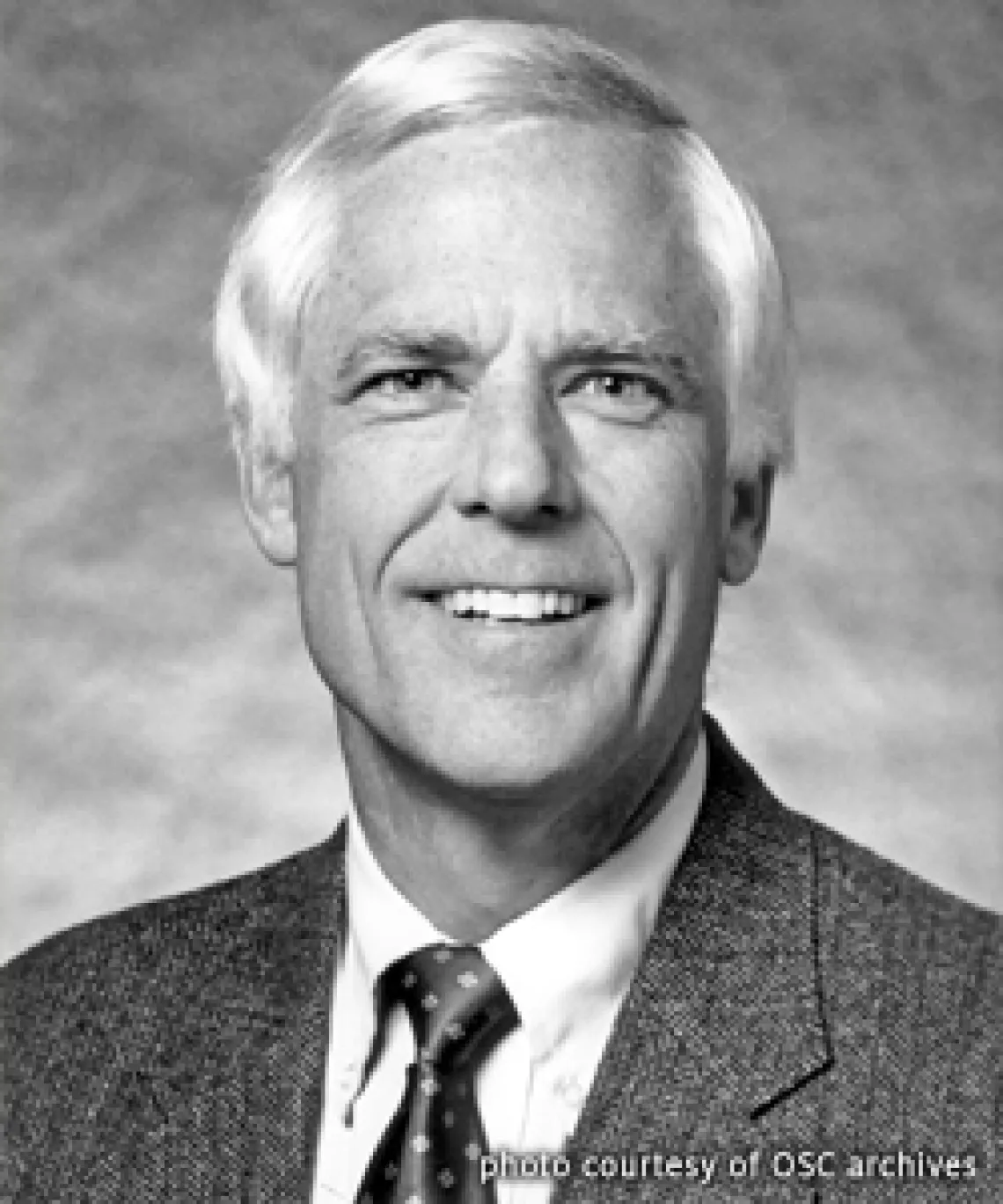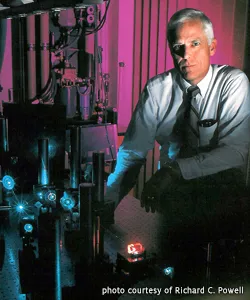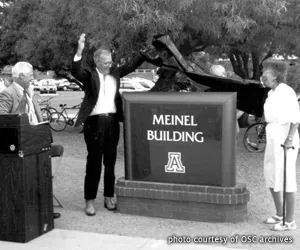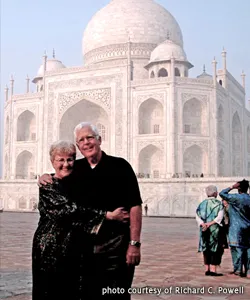Reflections: Richard C. Powell

"Yesterday, December 7th, 1941 … a date that will live in infamy." So began President Franklin Delano Roosevelt in a speech to Congress the day after Japan bombed the military base at Pearl Harbor.
During our lifetime, many of us will experience a moment that imprints itself on the fabric of our lives and the lives of an entire generation. For Professor Emeritus Richard (Dick) C. Powell that moment occurred the day after Japan bombed the military base at Pearl Harbor.
Though just shy of three years old at the time, Dick still vividly remembers his family gathered around a big Philco floor-model radio, listening to FDR's request for Congress to declare war — and, the next day, his father leaving for active duty in the U.S. Navy.
Strongly influenced by his father's military experience and commitment to service, Dick, upon graduation from high school, received a congressional appointment to the United States Naval Academy in Annapolis, Maryland. After being awarded a Bachelor of Science degree in 1962, he accepted a commission in the U.S. Air Force, who promised to send him to graduate school right away.
Graduate School
True to their word, the Air Force sent Dick to graduate school at Arizona State University (ASU) in Tempe. The invention of the transistor had just started to drive microelectronics and Dick had developed an interest in solid-state physics and in working with Ben Gossick, a solid-state physicist who had been instrumental in inventing the transistor.
But once he began at ASU, it became clear that the invention of the laser was the new "hot" topic. So Dick combined his interest in solid-state physics with his new interest in the laser, and became involved with optical properties of solids — his research focusing on the properties of oxide-semiconductor interfaces.
Upon completion of his master's degree, the Air Force chose to assign him to work at Cambridge Research Laboratories in Bedford, Massachusetts. Fortunately, Dick had already fulfilled ASU's course requirements for a Ph.D., so arrangements were made for him to do his thesis work in-absentia. He conducted research in the crystal growth laboratory at MIT and the optical spectroscopy laboratory at Mithras Inc., where the optical properties of laser materials were being studied. Dr. Baldassare (Rino) Di Bartolo, who directed the Spectroscopy Laboratory at Mithras, became Dick's supervisor on a project investigating the optical properties of heavily doped ruby. This project became the basis for his Ph.D. thesis.
As ASU required Dick to spend his final semester in residency, while taking all of the required written and oral exams, Dick initiated an Air Force contract with Motorola Semiconductor Division in Scottsdale, Arizona., and sent himself to work there on temporary assignment. He then registered for his final semester at ASU, passed all of his exams, and had Dr. Di Bartolo fly to Arizona to preside at his thesis defense. Dick was awarded his Ph.D. in Physics in 1967.
Government Labs

Dick's first "real" job in physics was as a staff scientist at the Air Force Cambridge Research Laboratories (AFCRL) in Massachusetts, where the focus was on developing new technologies for the Air Force. He was assigned to the Materials Research Laboratory, and given complete freedom to do anything he wanted. His first project was on radiation damage in semiconductor devices, but he later became active in using spectroscopy to evaluate and test materials for lasers. This generated a lot of interest within AFCRL and Dick received the Air Force Scientific Achievement Award and the Air Force Commendation Medal for his work.
Dick's obligation to the Air Force and his time at AFCRL both ended in 1968, and he moved to Albuquerque, New Mexico, to work at Sandia National Laboratories. He was assigned to a group in the Materials Division that was working on molecular crystals and polymers for a variety of applications. During his time at Sandia, Dick worked on two major projects. The first was studying energy transfer in doped aromatic hydrocarbons. The second project was studying saturation effects in plastic scintillators used to monitor radiation at the underground nuclear test site in Nevada.
Oklahoma State University
While at Sandia, Dick met Bill Sibley who was in research at Oak Ridge National Laboratory in Tennessee, before becoming the head of the physics department at Oklahoma State University (OSU) in Stillwater, Oklahoma. When Bill offered Dick the opportunity to switch to an academic environment as an associate professor of physics, he readily accepted and his career changed from just being isolated in a laboratory to spending his time teaching and mentoring students.
OSU had recently established a crystal growth laboratory and was developing an emphasis in solid-state physics. The main focus of Dick's research group was using special optical spectroscopy techniques to study the properties of active optical materials used for solid state lasers, photorefractive devices and nonlinear optical devices. This work resulted in over 250 scientific publications and productive sabbatical leaves at Caltech and Lawrence Livermore National Laboratory.
During Dick's time at OSU, he moved up to full professor, then was appointed to regents' professor, and finally given an endowed professorship from the Nobel Foundation. For a number of years, he did less teaching and more service work as an academic administrator, first as head of the physics department, then as associate dean of the College of Arts and Sciences, and finally as the director of the Oklahoma State Center for Laser Research.
Oklahoma School of Science and Mathematics
Dick considers one of the most important things he accomplished while in Oklahoma to be his role as one of the founding directors of the Oklahoma School of Science and Mathematics (OSSM) — a two-year public residential high school, located in Oklahoma City. Established by the Oklahoma state legislature in 1983, the school was designed to educate academically gifted high school juniors and seniors in advanced mathematics and science.
Since 1990, when doors opened to its inaugural class, OSSM has accepted students from each of Oklahoma's 77 counties — providing an opportunity to many students that was beyond the experience they would have had in their local public schools. To date, 100 percent of OSSM graduates have been college-bound, and approximately 60 percent of OSSM graduates chose to remain in-state for college.
UA Optical Sciences Center
In 1992, Bob Shannon, then-director of the Optical Sciences Center (OSC), retired and professor Hyatt Gibbs visited Dick in Oklahoma to talk about the possibility of him becoming the next director of the center. For Dick, it was a difficult decision which meant giving up the major research program he had developed at OSU. But after being convinced to visit OSC by the chair of the search committee, Peter Franken, he became so positively impressed with the faculty and the program that he was happy to make the move.
As director, Dick quickly discovered that one of the things that makes OSC unique is the breadth of its curriculum and research. "[But] trying to coordinate this wide range of activities into a cohesive academic unit was a major challenge when it came to curriculum, prelim exams, and promotion and tenure decisions." Additionally, Dick faced another major challenge — a budget deficit.

OSC was experiencing some difficult financial times and Dick attempted to get more state funding, but none was available. So, instead, he worked hard to negotiate a financial deal with the university that was probably the most important deal in the history of OSC — with the exception of the original founding of the center. He worked out a plan that allowed OSC to keep more of the indirect costs generated from grants and contracts. This was not "guaranteed" funding like state funding, but it rewarded OSC with additional funding from each grant and contract awarded. The faculty responded very well to this challenge and OSC's financial situation began to improve.
One of the highlights of Dick's six years as Director was the renaming of OSC's building. In 1970, when the original building was constructed and dedicated, Aden B. Meinel was OSC's founding director. On Oct. 28, 1993, the building was rededicated and named "The Meinel Building." Aden, along with his wife and research partner, Marjorie, attended the celebration which culminated in an outdoor dedication and unveiling of the new building sign.
UA Vice President for Research
In 1999, Dick was asked to serve as vice president for research, graduate education, and economic development for the University of Arizona (VPR). As managing funded research, scholarly work and research-focused graduate programs was a major component of his job as director of OSC, this move to join the senior leadership team of the university was a natural progression. As VPR, Dick collaborated with deans, faculty and colleagues in areas that supported the research mission of the university as a whole. "Getting involved with the entire campus — medical college, law school, fine arts and others — was a lot of fun."
One of Dick's main activities as VPR was serving as the university's representative on several governor advisory committees. This led to enhanced funding for higher education in general, and optics in particular, through programs such as TRIF. He also was a strong advocate for optics and basic research, in general, at the national level — serving on many program evaluation committees and testifying before Congress on behalf of the critical need for science funding.
As one of the major academic research institutions in the country, the University of Arizona was involved with many mega-projects which involved major commitments from the leadership of the university and, as VPR, Dick spent a lot of time with those projects. One example was the multi agency Phoenix Mars Lander project, headed by the university's Lunar and Planetary Laboratory, under the direction of NASA's Jet Propulsion Laboratory. Honored to be the first public university to lead a mission to Mars, the mission was the first in NASA's Scout Program, combining legacy and innovation in a framework of a true partnership — government, academia and industry.
Another mega-project the university was involved with was the building of the Large Binocular Telescope (LBT). As VPR, Dick served on the board of directors of the LBT Corporation as they designed, built, and commissioned one of the world's most advanced telescopes. The telescope design had two 8.4 meter mirrors — successfully cast at the University of Arizona's Steward Observatory Mirror Lab (now named the Richard F. Carris Mirror Lab).
Retirement
At the age of 65, Dick decided it was time to retire and was appointed as an emeritus professor and vice president. For the first couple of years, he stayed very active with the university, teaching a laser course and working with the solar energy research consortium, AZRise. Then little by little, Dick phased out university work and did more consulting. C-path was a new organization that was focused on faster paths to FDA approval of new drugs and medical equipment, and he helped them make research contacts within universities. Dick also aided Science Foundation Arizona with launching a research effort in solar energy technology, and he worked with Research Corporation for Science Advancement on their funding of solar projects.
After a few years, these efforts died down and Dick began to focus on giving public lectures on scientific topics such as lasers and their applications, and solar energy technology. And, currently, he is a senior fellow at the UA Science and Tech Park working on the expansion of their Solar Zone to test, evaluate and demonstrate solar technologies.

Even though Dick still works most weekday mornings, he has managed to find time for a couple of enjoyable pastimes. The first, astrophotography, stemmed from his experience serving on the board of the Large Binocular Telescope project. He bought an 8-inch telescope and modified it to take photos of nebula, galaxies, star clusters and other deep space objects. Dick gives talks on this subject in both Tucson and southwest Colorado where he and his wife, Gwen, spend the summers.
Another of Dick's favorite activities is traveling with Gwen to some of the world's most beautiful destinations. They have hiked the Inca trail to Machu Picchu, experienced Indian culture in the Golden Triangle, floated down the Nile in Egypt, visited the mammoth Iguazu Falls in South America and zip lined through the rain forests of Costa Rica — with plans to keep traveling for as long as they can.
Books Published
- Physics of Solid State Laser Materials
- Symmetry, Group Theory and the Physical Properties of Crystals
- Crystal Symmetry, Lattice Vibrations and Optical Spectroscopy of Solids (with Baldassare Di Bartolo)
Awards and Honors
- Elected President of OSA, 2001
- Elected Fellow of OSA
- Elected Fellow of APS
- Elected to Russian Academy of Engineer Science, 1999
- MASUA Honor Lecturer, 1989-80
- Sigma Xi Honor Lecturer, 1983-84
- IR 100 Award, 1967
- Air Force Commendation Medal, 1968
- Air Force Scientific Achievement Award, 1967
